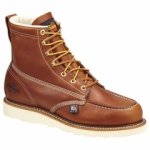I think that there must be some tradition or history in this. In the past, shoe soles were made from pieces of leather and leather is a somewhat flat material. It has a more or less uniform thickness. So, a shoe made with a leather sole would have a uniform thickness. But our feet really need more of a natural curve for the best comfort. So, as a first attempt to get that curve, a heel was added. The original heels were probably made from layers of, guess what, leather that were glued and nailed together. Well, men's heels anyway.
This idea of a flat bottom may have been invented earlier, but it has only been popular since the advent of inexpensive and durable materials that can be formed in a mold. I am sure it could have been done with layers of leather that were tapered, but how many shoes have you seen made that way? I have seen zero. The opening between the toe and heel may have been nothing more than an economy measure, both in terms of materials and in the labor needed to make a more complicated, tapered stack of leather.
Having spent some years in the north where snow and slop are common in the winter, I have come to favor the flat soles because you track in less of it. They also have more area for more resistance to slipping on ice.





